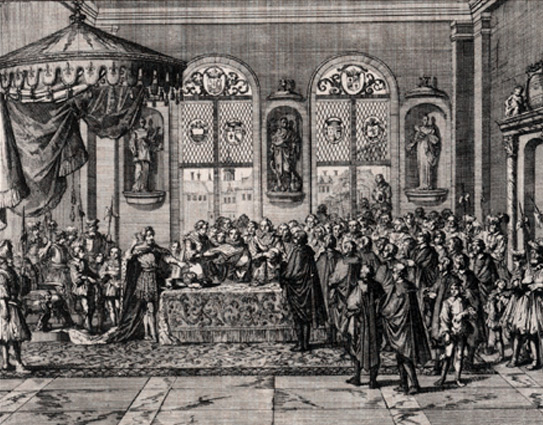The Edict of Nantes was the royal decree of Henry IV that ended the French Wars of Religion in 1598.
In 1562 the massacre of a Huguenot congregation in Vassy, carried out by Francis, duke of Guise, triggered the French Wars of Religion. The Catholic noble houses led by the duke, a religious fanatic, escalated the nationwide violence against the so-called Huguenot (Calvinist) heresy. In response, the Huguenots, with Henry of Navarre as their leader, retaliated by devastating Catholic communities under their control.
The ongoing religious conflict was complicated by political struggles within the royal court. After the death of Henry II in 1559, his three sons, Francis II, Charles IX, and Henry III, would successively wear the crown.
  |
Their mediocre political and military skills left a vacuum at the heart of royal authority, which enabled the House of Guise to make a move. Queen Catherine de Médicis, their mother and a Machiavellian stateswoman, was determined to defend the hereditary rights of her three sons and preserve the Crown for her family.
After three major military confrontations and two failures to sustain negotiated peace in the 1560s, the two sides reached the third peace at St. Germain in 1570, which offered more favorable deals to the Huguenots.
On August 23, 1572, the Huguenots from all over France gathered in Paris to celebrate the marriage of their leader Henry of Navarre, now a converted Catholic, to Margaret, the queen’s daughter. The reconciliatory event, however, turned into a massacre of the Huguenots by the Catholic faction of the court.
 |
| Revocation of the Edict of Nantes |
It remains murky whether or not Catherine de Médicis personally conspired in or ordered such a senseless bloodshed. The havoc of St. Bartholomew’s Day, however, killed an entire generation of Huguenot leaders, claimed more than 15,000 innocent lives, and, thereafter, prolonged the Wars of Religion for another two decades.
The turning point of the domestic crisis came with the Wars of Three Henries (1584–89), Henry of Guise versus Henry of Navarre versus Henry III, who had ascended to the Crown in 1574. During the war, Henry of Guise, whose ambition now was to succeed Henry III, conspired with Philip II of Spain, who needed the French support for checking England and suppressing the Netherlands’s Protestant rebellion.
In 1588, Henry of Guise and his Catholic League marched into Paris, besieged Henry III, and pressed him to abdicate the throne. While being still free, Henry III, a pious and militant Catholic, allied with Henry of Navarre, who converted back to the Huguenot faith after the St. Bartholomew’s Day massacre.
   |
After the king made his own brother-in-law the heir to the throne, the two Henries marched against Henry of Guise and the Catholic League. Soon, the bodyguards of Henry III assassinated Henry of Guise. Shortly thereafter, the aged queen died and a Dominican monk murdered Henry III. Henry of Navarre, the only survivor, succeeded to the throne of France as Henry IV in 1589.
It took a full decade for the first Bourbon king, Henry IV, to end the religious wars and to reconstruct peace. He solemnly adjured his Huguenot faith again to become a Catholic in 1593. This compelled Pope Clement VIII to grant him absolution in the same year. The peace with Rome enabled him gradually to dissolve the Catholic League in France and pacify Spain overseas.
State Religion
On April 13, 1598, Henry IV promulgated an edict in Nantes, Brittany. It ordained that Catholicism would be restored and reestablished as the religion of the state, and the Catholic Church would preserve its privilege of collecting tithe, observing holidays, and enforcing restrictions regarding marriage. Meanwhile, it permitted Protestants to live in the kingdom without being questioned, annoyed, or compelled to change their faith against their conscience.
Moreover, the edict offered Protestants rights to property, to public offices, to education in a few designated Protestant colleges, to holding their own synod, and to having cases involving breaches of the edict to be adjudicated by special courts composed of half Catholic and half Protestant judges. It further bestowed on Protestants freedom of worship in about 100 fortified towns and cities outside the city of Paris, where they retained right to self-defense for eight years.
The Edict of Nantes appeared unpopular among both the Catholics and the Protestants at the time, but Henry IV had the personal charm and the political strength to implement and enforce it.
While Europe was engulfed by religious wars, the edict defied the existing ideal of universal faith: “one faith, one law, one king” (une f oi,un loi, un roi) and experimented with a policy that was more tolerant than the principle of “as the ruler, so the religion” (cuius regio, eius religio) embodied in the Peace of Augsburg of the Holy Roman Empire in 1555.
